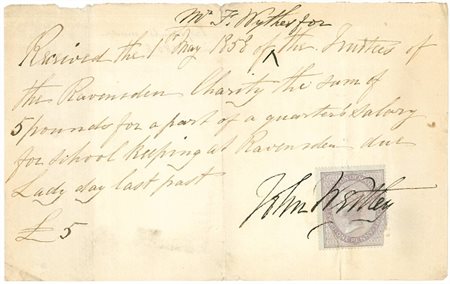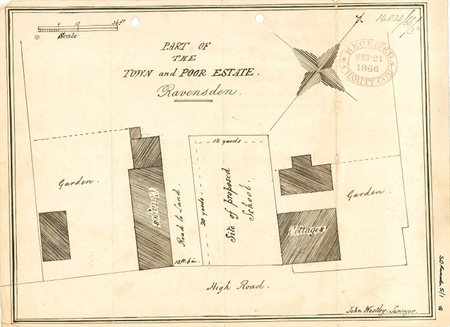Education in Ravensden up to 1867
This page was written by Trevor Stewart with contributions by Bedfordshire Archives Staff
Until the early 19th century little formal education existed for the rural poor and even where it did exist it was provided mainly through the support of the local church or the philanthropy of the squire. We know that in the early 1700s there was no school at Ravensden. This was not uncommon; Ravensden was one of 55 parishes in Bedfordshire that had no school at the time according to returns made to the Bishop of Lincoln (quoted below). 54 parishes in the county did have some form of educational provision.
Records from a series of episcopal visitations which took place in the early 18th century were published by the Bedfordshire Historical Record Society in 2002 (volume 81, edited by Patricia Bell). At each visitation a list of questions was sent out in advance, one of which enquired about the provision of schools in each parish. In 1706 the return for Ravensden stated that “There is no Lecture, Schole, Almeshouse, or Hospital endowed within this parish. No Person of Quality or Gentleman of Estate lives in it.” The returns of 1709, 1717 and 1720 also recorded that there was no school in the parish.
In Ravensden education was first provided through the establishment of a Sunday School. In the early 1780s a Gloucester man named Robert Raikes embarked upon a national campaign to encourage Sunday Schools to teach the basics of reading, writing and sums, based on the Bible and religious texts. By 1831 this had proved enormously successful and it is thought that as many as 25% of the population were then receiving a fundamental education by that means.
The earliest mention known of the Sunday School at Ravensden is from a parliamentary investigation of 1818 which found 'A Sunday school, supported by voluntary contribution, in which about 45 children are instructed. From the regularity with which the Sunday school is attended, the poor would gladly embrace any other opportunities of instruction'' (The Bedfordshire Schoolchild: Elementary Education before 1902, published by Bedfordshire Historical Record Society, 1988 volume 67 p51). By 1833 the Ravensden Sunday School consisted of 27 males and 27 females.
It was probably in about 1845 that a day school began as the Church School Inquiry of 1846/47 reported that the Sunday School had 13 boys and 13 girls and the day school 29 boys and 25 girls with the comment 'The Daily School is quite in its infancy' (The Bedfordshire Schoolchild: Elementary Education before 1902 published by Bedfordshire Historical Record Society, 1988 volume 67 p120). The first entry for coal for the day school appears in the churchwarden's accounts in 1847 (P89/5/2).
 Entry for coal (P89/5/2)
Entry for coal (P89/5/2)
In 1848 one of the scholars at the day school was Emma Peacock, aged 12, whoo lived with her family at Brick Farm (later known as Home Farm). Emma produced a ‘’Summing Book’’, the original is still held by a local resident but Bedfordshire Archives holds a photocopy of it.
In 1858 the trustees of the Ravensden Town and Poor Estate charity consulted the Charity Commission on whether, under the terms of the act of parliament passed in 1841 ‘to afford further Facilities for the Conveyance and Endowment of Sites for Schools,’ they could build a school and master’s residence on a portion of the charity’s property and pay 20 guineas per annum out of the rents of the charity property towards the stipend of a master. The Charity Commission responded on the 19 May 1858 authorising this on condition that: ‘the master (who shall be a member of the Church of England) is to be appointed by the Trustees; the Vicar of Ravensden for the time being shall have the superintendence of the School and that the School shall be open to the children (boys and girls) of all denominations and that the children of dissenters shall not be required to attend the Parish Church or to learn the Church Catechism if these be objected to by their parents or guardians’ (SDRavensden5/1C). This consultation was a bit late as the Trustees had already begun to pay a schoolmaster from at least the beginning of May that year.
John Westley, Schoolmaster
On the 5th April 1858 the aforementioned Emma Peacock married John Westley, schoolmaster. On the 1st May 1858 John signed a receipt for a £5 payment made for part of a quarter’s salary for school keeping at Ravensden. John Westley would continue to teach at the school until 1873.
 Receipt for £5 signed by John Westley, 1 May 1858 (P89/25/7)
Receipt for £5 signed by John Westley, 1 May 1858 (P89/25/7)
John Westley was born in Ravensden on the 3 August 1831 to John and Hannah Westley. John Westley senior was landlord of the Horse and Jockey public house from at least 1828 until his death in 1837. Hannah Westley carried on as publican after her husband’s death and on the 26 October 1841 she married James Farrer, a labourer. In 1851 the 19-year-old John Westley is listed on the census at the Horse and Jockey with his mother and step-father; his occupation is given as ‘farmer’s son’ presumably indicating he, at that time, was helping to run the farm and pub with his parents. It is not known exactly when between 1851 and 1858 he began teaching at the school or who taught the school before him. In 1861 John and Emma are living in Struttle End, close to Emma’s family at Brick Farm. By 1871 they are still at Northfield End and John’s occupation is now given as schoolmaster and farmer. By 1881 John is a farmer of 110 acres and an accountant and registrar. He seems to have been a capable man and went on to have a long career as a land surveyor, registrar and in various administrative roles. He continued to be involved with the charity trustees and the managers of the school. He died in 1922 at the age of 90. John and Emma had four children: Samuel John, Annie Sarah, Elizabeth and William. Annie Sarah became clerk to the Ravensden school managers, a position she held until her death in March 1937.
The first school building
According to Trevor Stewart, a memoir of an elderly Ravensden born resident (Mr Bill Cambers) written in the early 1960s says ‘that his grandfather was one of a large family born in Graze Hill Lane in 1846…what schooling he (his grandfather) had was in the Vestry at Ravensden Church’. Although, we know that the Trustees of the Town and Poor Estate Charity wanted to build a school in 1858 the school was to remain in the vestry until 1867.
In 1858 the Charity Commissioners were supportive of the idea but the funding available was inadequate. The trustees went as far as getting a plan and tender from Edward Haynes for the building of the school in 1863, but at £208.19s this was still too expensive (SDRavensden5/2).
In 1865 the trustees again wrote to the Charity Commissioners for further advice (SDRavensden5/1E). They stated that ‘the present Day & Sunday School is held in the Vestry adjoining the Parish Church there being no other building available for the purpose’. They then had £118 in the bank and had an estimate that £150 would be sufficient to build a room sufficient for the requirements of the parish. They asked if they could proceed to build at once ‘so as to get it completed during the summer’. The Commissioners pointed out that the trustees had not done everything they needed to do in order to convey the land on which the school would be built and this rather delayed matters.
In 1866 the ever useful John Westley drew a plan of part of the Town and Poor Estate Ravensden showing the site for the proposed school.
 Plan of proposed school site, 1866 (SDRavensden5/1G)
Plan of proposed school site, 1866 (SDRavensden5/1G)
Finally, on the 28 November 1866 the trustees of the charity conveyed by deed poll the land for the school to the managers of the school. The plan shown on the deed is only slightly different to that on John Westley’s plan. The land was in Church End, west of and adjoining the Charity Field.
Tenders were received and that of J T Wing for £200 was accepted. The school was to be built to his plan dated March 1867 (SDRavensden5/3). It was finished by December 1867 when a meeting of the trustees of the school was held there to inspect the building and audit the accounts. The school consisted of one room 28 feet 6 inches in length, 20 feet 6 inches in breadth and 10 feet high.
 Plan of school by J T Wing, March 1867 (SDRavensden5/3)
Plan of school by J T Wing, March 1867 (SDRavensden5/3)